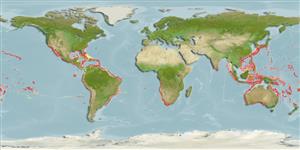Common names from other countries
Environment: milieu / climate zone / depth range / distribution range
Écologie
marin benthopélagique; profondeur 150 - 400 m (Ref. 6181). Tropical; 37°N - 37°S, 180°W - 180°E (Ref. 6181)
Atlantic Ocean: Walvis Ridge, off Puerto Rico and Uruguay. Indian Ocean: off western Australia. Pacific Ocean: off New Guinea, southern Japan, Midway Island, California, Nazca and Sala y Gomez Ridge.
Taille / Poids / Âge
Maturity: Lm ? range ? - ? cm
Max length : 250 cm SL mâle / non sexé; (Ref. 9351); common length : 200 cm SL mâle / non sexé; (Ref. 9351)
Rayons mous dorsaux (Total) : 116 - 123; Épines anales: 2; Rayons mous anaux: 74 - 87; Vertèbres: 125 - 129. Body very elongate and compressed. Head profile straight or scarcely convex, with sagittal crest strongly elevated. Both jaws have a short dermal process; the lower jaw longer than the upper jaw. The dorsal fin has a few weak anterior spines that hardly differ from the soft rays. Body color silvery, dorsal fin membrane black before the third to the fourth soft ray.
Probably benthopelagic from 150 to 400 m, juveniles epipelagic or mesopelagic. Feeds on fishes (including Engraulis mordax and Merluccius productus off California) and squids. Occasionally hooked, captured in nets, or found washed ashore. No special fishery.
Life cycle and mating behavior
Maturities | Reproduction | Spawnings | Egg(s) | Fecundities | Larves
Nakamura, I. and N.V. Parin, 1993. FAO Species Catalogue. Vol. 15. Snake mackerels and cutlassfishes of the world (families Gempylidae and Trichiuridae). An annotated and illustrated catalogue of the snake mackerels, snoeks, escolars, gemfishes, sackfishes, domine, oilfish, cutlassfishes,. scabbardfishes, hairtails, and frostfishes known to date. FAO Fish. Synop. 125(15):136 p. (Ref. 6181)
Statut dans la liste rouge de l'IUCN (Ref. 130435)
CITES (Ref. 128078)
Not Evaluated
Menace pour l'homme
Harmless
Utilisations par l'homme
Pêcheries: pêcheries vivrières
Outils
Articles particuliers
Télécharger en XML
Sources Internet
Estimates based on models
Preferred temperature (Ref.
115969): 10 - 20.6, mean 14.7 (based on 279 cells).
Phylogenetic diversity index (Ref.
82804): PD
50 = 1.0000 [Uniqueness, from 0.5 = low to 2.0 = high].
Bayesian length-weight: a=0.00054 (0.00022 - 0.00132), b=3.13 (2.93 - 3.33), in cm Total Length, based on LWR estimates for this (Sub)family-body shape (Ref.
93245).
Niveau trophique (Ref.
69278): 4.5 ±0.69 se; based on food items.
Résilience (Ref.
120179): Faible, temps minimum de doublement de population : 4,5 à 14 années (Preliminary K or Fecundity.).
Fishing Vulnerability (Ref.
59153): Very high vulnerability (90 of 100).
